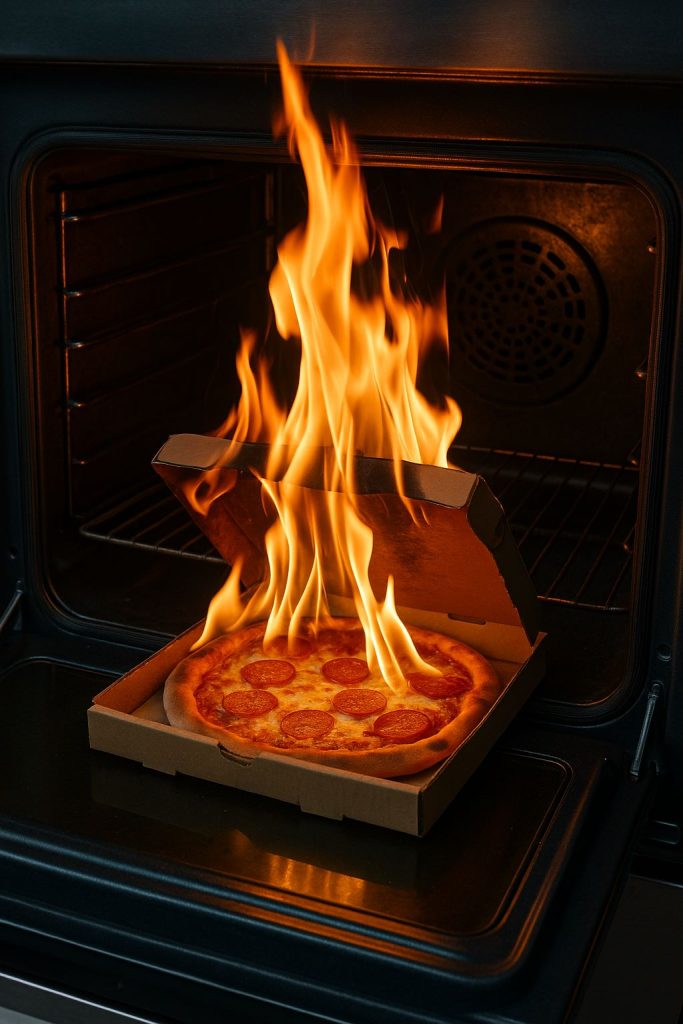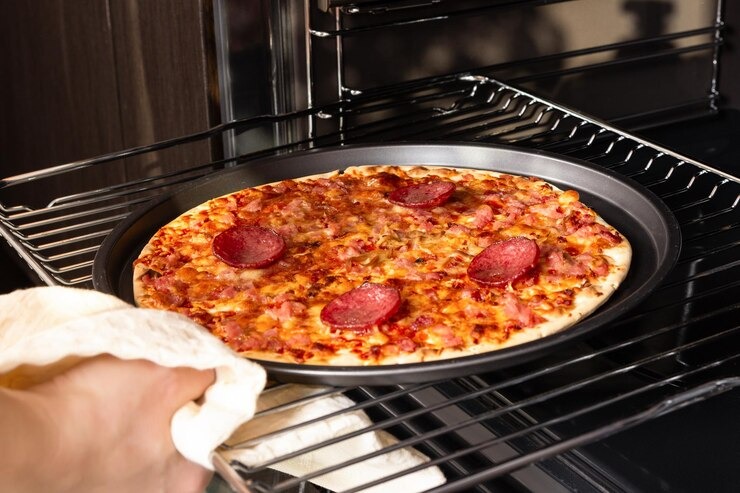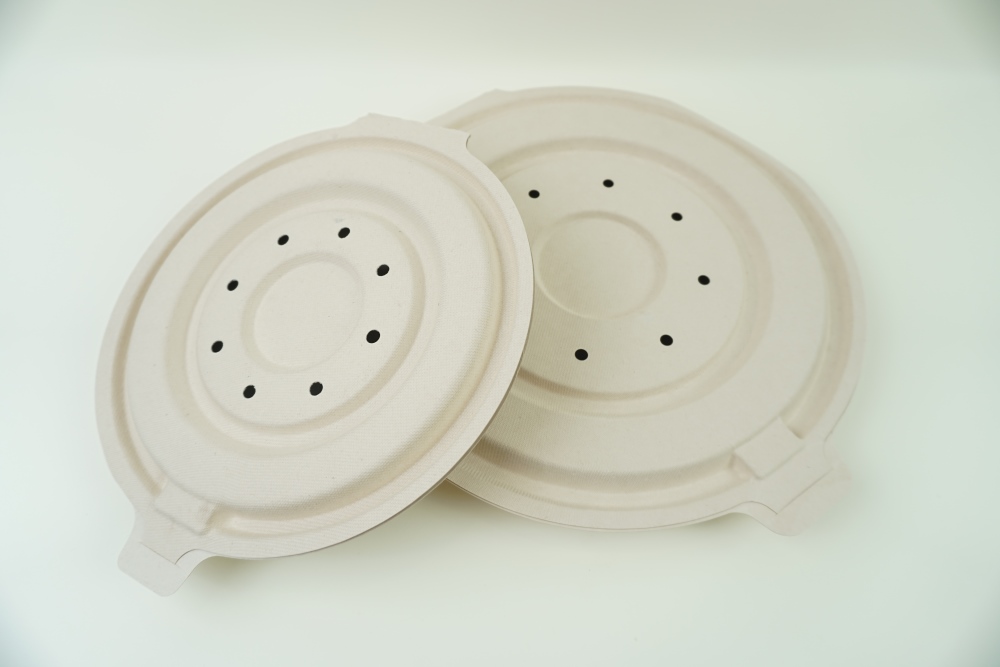Why This Question Comes Up So Often

Can You Put Pizza Box in Oven? It’s a Friday night, and your favorite pizza place has just delivered a fresh, cheesy pie for your gathering. The smell is irresistible, but not everyone has arrived yet — so the pizza needs to stay warm until it’s time to eat. You glance at the oven and think, “Maybe I can just put the whole pizza box in there.”
It’s a situation many people have faced. It feels convenient, avoids extra dishes, and seems harmless enough. But is it really safe to put a pizza box in the oven? And what about the impact on your health and the environment?
The short answer: it’s not recommended — and for good reason. Let’s break down why, and what you can do instead.
What Pizza Boxes Are Made Of — And the Risks of Heating Them
1. Common Materials Used in Pizza Boxes
Most pizza boxes are made from corrugated cardboard — a durable, lightweight material that insulates well and is relatively inexpensive. But corrugated cardboard has a flashpoint (the temperature at which it can catch fire) of about 218–246 °C (424–475 °F). While your home oven may not reach that temperature instantly, prolonged heating or contact with heating elements can cause scorching, smoking, or even ignition.
Beyond the cardboard itself, pizza boxes usually include:
- Printing inks for branding and product information
- Adhesives to hold the structure together
- Grease- and moisture-resistant coatings, sometimes containing PFAS for oil resistance
These additions mean your pizza box isn’t just “plain paper” — it’s a mix of materials that behave differently under heat.
2. Potential Hazards When Heated

When you place a pizza box in the oven, several things can happen:
- Chemical migration – Heat can cause certain substances in inks, adhesives, and grease-resistant coatings to leach into your food. These may include:
- Per- and polyfluoroalkyl substances (PFAS) – Often used to make pizza boxes resistant to grease, PFAS can migrate into pizza when heated. Long-term exposure has been linked to thyroid disease, decreased fertility, certain cancers, and liver or kidney damage.
- Diisobutyl phthalate (DIBP) – A chemical sometimes detected in pizza box materials, DIBP is associated with cancer risk and potential birth defects.
- Bisphenols – Compounds occasionally found in food-contact packaging that can transfer into pizza under heat, posing risks to hormone regulation and overall health.
- Fire risk – Cardboard is combustible. Even if it doesn’t ignite, the surface can char or smoke at high heat.
- Unpleasant fumes – Heating adhesives and coatings can produce odors or smoke that alter the taste of your pizza and pollute indoor air.
In short, pizza boxes are built for transporting hot food — not for baking or reheating.
Bonus Tip: How to Keep Pizza Warm
If your pizza is still hot but you’re waiting for the right moment to serve it — maybe guests haven’t arrived yet — you can keep it warm without turning on the oven:
- Use Heated Car Seats – Perfect for keeping takeout pizzas warm on the way home.
- Use an Insulated Pizza Bag – Like delivery drivers, these keep heat locked in for longer.
- Place the Box on Top of the Oven (Not Inside) – Gentle warmth without direct heat exposure.
- Heat-Resistant Compostable Plates – InNature Pack’s bagasse pizza box are sturdy, grease-resistant, and keep slices presentable while staying eco-friendly.
- Preheat the Oven Briefly, Then Turn It Off – Warm to about 200°C (392°F) for a few minutes, switch it off, and place the pizza (without the box) inside to hold its temperature.
How to Safely Reheat Pizza
If your pizza has cooled, these methods bring back the fresh-baked texture while keeping safety and flavor in mind.
Using the Oven Safely

- Pizza stone or preheated baking sheet – Heat your oven to about 190°C (375°F) with the stone or sheet inside. Once hot, transfer your pizza directly onto it and bake for 5–10 minutes. This method crisps up the base and evenly warms the toppings.
- Wrap in aluminum foil – For more moisture retention, wrap slices loosely in foil before placing them in the oven. This helps keep the cheese melty while preventing the crust from drying out.
No-Oven Ways to Reheat Pizza
- Stovetop skillet method – Place slice in a hot pan over medium-low heat. Cover to trap steam; in 2–3 minutes, the bottom crisps up while cheese melts. For extra moist finish, add a few drops of water to the pan before covering.
- Microwave + skillet finish – Place slice and a cup of water in the microwave; heat 30–60 seconds in short bursts until warmed through. Then, transfer to a hot skillet for about a minute to crisp up the crust.
- Air fryer method – Preheat the air fryer to 175°C (350°F). Place slices in a single layer inside the basket and heat for 3–4 minutes. This method restores a crunchy crust while keeping the toppings warm and melty. Avoid overcrowding to ensure even heating.
Why Sustainability Matters in Pizza Packaging

Most used pizza boxes can’t be recycled because grease and cheese residue contaminate the cardboard fibers. Even some “compostable” boxes fail to break down due to plastic linings or chemical coatings.
InNature Pack’s bagasse pizza boxes offer a better option:
- PFAS-free and food-safe
- Grease- and water-resistant without plastic linings
- 100% biodegradable and compostable
- Customizable printing for brand visibility
- Short-Term Oven Safe – Tested to withstand up to 200°C (392°F) for 45 minutes without loss of strength or performance. This is ideal for brief warming in professional kitchens. However, to avoid fire hazards, we recommend never leaving the oven unattended and not using the box for prolonged heating.
By choosing sustainable materials, restaurants can reduce waste, protect customer health, and align with eco-conscious values.
Final Thoughts — The Verdict on Pizza Boxes in Ovens
So, can you put a pizza box in the oven?
While certain eco-friendly boxes (like ours) can handle short bursts of oven heat, the safest and most responsible answer is no for general consumer use. There are better ways to keep your pizza warm or reheat it that don’t risk chemical exposure, fire hazards, or sustainability setbacks.
For food businesses, switching to InNature Pack’s oven-safe (short term), compostable pizza boxes is a step toward greener, safer food service.
Ready to serve pizza safely and sustainably?
Contact InNature Pack today to request free samples or discuss custom designs for your business.
FAQ
Q1: Can you put a pizza box in the oven?
A: Not recommended. Cardboard is flammable, and heating can release harmful chemicals into your food.
Q2: Are InNature Pack pizza boxes oven-safe?
A: They can withstand up to 200°C (392°F) for 45 minutes without losing strength, but we recommend short-term use only — never leave them unattended.
Q3: What chemicals might leach from a heated pizza box?
A: Potential substances include PFAS, DIBP, and bisphenols, all of which can pose health risks when ingested.
Q4: How can I keep my pizza warm without the oven?
A: Use an insulated pizza bag, place the box on top of the oven, or briefly preheat and then switch off the oven before placing the pizza inside (without the box).
Q5: What’s the safest way to reheat pizza?
A: Remove it from the box and use a pizza stone, baking sheet, skillet, air fryer, or microwave + skillet method for best texture and safety.

